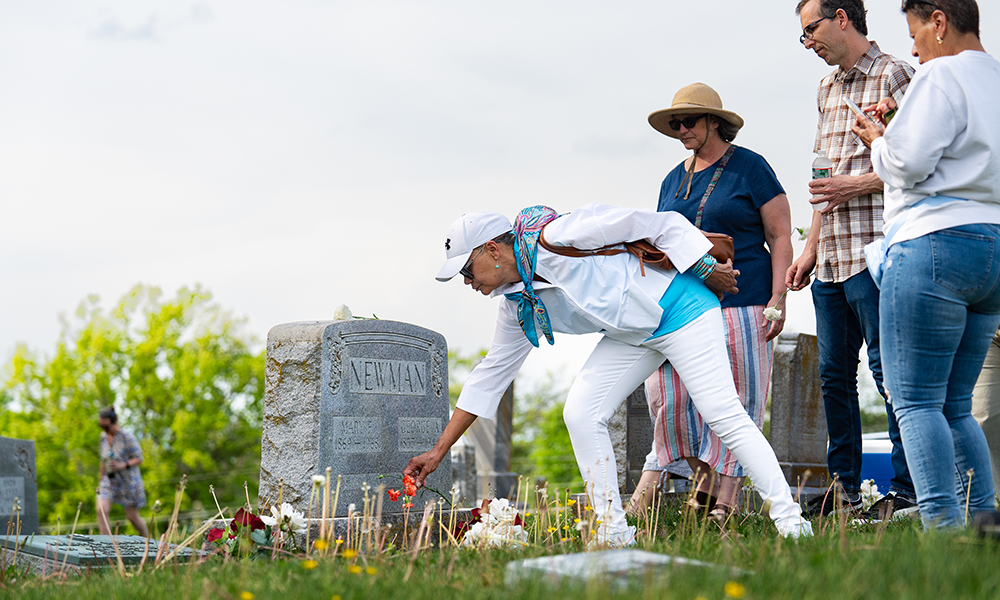A book 150 years in the making
News
SUMMARY: 150 years after it was first penned, one man's novel is being brought to life through a collective effort from across Rockingham County, highlighting the value of material preservation, archive-building, faculty research and student applied learning all at once.
A collective effort from across Rockingham County made national history this year with the publication of Rev. George A. Newman Sr.’s novel A Miserable Revenge: A Story of Life in Virginia. 150 years after it was first penned, Newman’s novel brought together Harrisonburg community members, local educators, faculty from Eastern Mennonite University and Old Dominion University and JMU faculty, students and staff from Libraries and the Department of English in recovering, producing and digitizing the novel.
 The manuscript had been in the possession of Newman’s granddaughter, Ruth Toliver, who noticed the pages beginning to tear and yellow. Thinking of all the lost Black history in America, Toliver called it “humanistically essential” to preserve the manuscript and to incorporate her private family collection into broader records of Black history.
The manuscript had been in the possession of Newman’s granddaughter, Ruth Toliver, who noticed the pages beginning to tear and yellow. Thinking of all the lost Black history in America, Toliver called it “humanistically essential” to preserve the manuscript and to incorporate her private family collection into broader records of Black history.
She turned to JMU Libraries’ Special Collections, and in February 2021, donated the manuscript along with other family papers. Seeing the value of the manuscript, archivists Kate Morris and Tiffany Cole immediately reached out to JMU English professors, Mollie Godfrey and Brooks Hefner, who specialize in American and African American literature. They jumped at the chance to involve graduate and undergraduate students in the transcription, digitization, and publication of the novel, and to introduce them to the applied practices of material preservation, public history and community engagement.
George Newman was born in 1855 in Winchester, VA to free Black parents. He learned to read and write at a young age and was apprenticed to a family of white farmers in exchange for receiving further education in Washington, D.C. In 1875, Newman moved to Harrisonburg, VA, where he served as the principal of a local African American school and became very involved in Black civic life. Researchers believe he began writing his novel just a year later.
Hefner calls the book “a wild ride,” full of unusual, over-the-top narrative devices and a plot that is at times difficult to discern and even harder to describe. Set in antebellum-era Frederick County, VA, the story follows a handful of townspeople as they navigate love triangles, mistaken identities and dark secrets plaguing the town’s past.
Though the novel follows certain narrative conventions of the period, such as frequently addressing the reader directly, it is unique in ways that are important for literary and cultural history. “We know about several slave narratives from the Shenandoah Valley,” Godfrey says, “but A Miserable Revenge is one of the area’s only fictional works written by a Black author during that time.” Even more exciting is its genre: though the novel does feature a semi-autobiographical character named “George,” it centers primarily on white characters — a genre known as “white life” literature, which became popular in the 1890s. Given the estimated time frame of its composition, 1876 – 1877, Newman’s work may be the earliest-known “white life” novel ever discovered.
These discoveries were only possible because of a series of grant-funded steps undertaken by Godfrey and Hefner. They secured an external grant from Virginia Humanities to employ JMU English graduate students Evan Sizemore (‘23M) and Jeslyn Pool (‘23M) to transcribe and date the novel, which included examining the paper Newman used, dating materials written on the back of manuscript pages, and matching days and dates in the novel to real calendars Newman may have used while writing.
With this foundation, Godfrey and Hefner secured a second Virginia Humanities grant, this time to create an electronic version of the book that includes contextualizing and companion essays from family members, local historians, K-12 educators and literary scholars.
Additional support through a Legacy Award from CAL — an award that supports teacher-scholars who involve students directly in scholarly research — helped Godfrey develop her Spring 2025 Advanced Studies in African American Literature course on local Black literature. Students studied a variety of locally written Black fiction, including Newman's novel, as well as Black life in Harrisonburg. As part of independent projects, students created lesson plans, organized an interview with Ruth Toliver, and created a widely accessible companion website for the novel featuring archival resources and interactive materials.
 The year-long project culminated in a public symposium celebrating the novel's publication on May 1, 2025, at the Lucy F. Simms Continuing Education Center in Harrisonburg. The symposium featured tours of the Dallard-Newman House, Newtown Cemetery, and Lucy F. Simms School, and a panel exploring the significance of Newman’s work from historical, literary, local, educational and personal perspectives.
The year-long project culminated in a public symposium celebrating the novel's publication on May 1, 2025, at the Lucy F. Simms Continuing Education Center in Harrisonburg. The symposium featured tours of the Dallard-Newman House, Newtown Cemetery, and Lucy F. Simms School, and a panel exploring the significance of Newman’s work from historical, literary, local, educational and personal perspectives.
Attendees received a copy of the novel, signed by Ruth Toliver. The paperbacks were part of a limited grant-funded print run created for Newman family members and for distribution to local libraries and schools.
As a celebration of community collaboration and public history — particularly local, Black history — the event was more than a book launch. It highlighted the unseen work that goes into material preservation, archive-building, faculty research and student applied learning — all of which CAL is dedicated to supporting.
